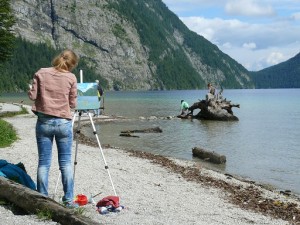Plein Air Painting Tips
 Many experienced plein painters believe that outdoor painting requires using smaller canvas. There are some particularly skilled artists who can paint large surfaces relatively quickly before light conditions get too radically different, but those who enjoy painting precise shades and shadows are advised to stick to small canvases.
Many experienced plein painters believe that outdoor painting requires using smaller canvas. There are some particularly skilled artists who can paint large surfaces relatively quickly before light conditions get too radically different, but those who enjoy painting precise shades and shadows are advised to stick to small canvases.
Don’t try to be too light weight by dumping tubes and paints in the studio, they are not heavy.
Picking the right colors to carry into the field can be a difficult choice to make, but it can certainly be made intelligently.
With this said, if one has dozens of tubes, there is no need to carry everything. Take one of each and leave the rest behind. Getting too bulky is not what plein air painting is all about.
When going outdoors small tubes are lighter and more convenient, but lest not forget they’re also a lot more expensive. A smart tip would be to buy the big tubes whenever you can, use them in the studio until they are half empty and then transfer them to your plein air backpack.
Check out this painter’s plein air demo
Some painters carry only shades of colors to match their environment and the light conditions they anticipate. An evergreen forest at dusk will call for a darker selection of basic colors, while a desert plain at noon will call for a bright palette. A grey snowy day will call for a sizable amount of white paint, possibly even a second tube of paint in a different shade of white if a plein painter is feeling up to the challenge.
Prepare the palette in advance. Most of us do not have endless time to stay out in the field. Preparing the palette in the studio can leave you more painting time once you are outdoors. For watercolor painters, prior palette preparation can be done only with air tight palettes.
Acrylic and oil painters can use any folding palette.
Keep in mind that outdoor paintings tend to darken drastically when they’re brought inside. So when preparing your palette try and keep your tones lighter than you think you see. The sunlight glare will bias your sense of shades at the beginning.
Know were you are going. If the car will be near by you can take heavier easel and more painting gear. If you are planning to go off track, take a smaller tripods and canvases.
Take 3-4 of your best brushes. Learn how to create the most of each brush.
You may want to take a water container that hangs from your easel. Unlike the studio a can which is placed on a rock or on your knees may flip over easily.
Cleaning and maintenance
Cleaning brushes can be a great challenge when painting outdoors. While parks may have fountains and some environments offer natural places to clean a brush, most outdoor plein painters must bring their own water to clean their brushes. Stirring in a container of water, ideally as larger as one can get without overburdening themselves, is the traditional way of washing brushes, but over time these containers can contaminate your colors, requiring the water be refreshed periodically.
In order to enjoy a long and relaxed painting outdoors, make sure you bring a wide brim hat, UV sunscreen lotion, cell phone, and water or coffee to drink. Don’t forget to bring paper towels, trash bags and bug spray.
